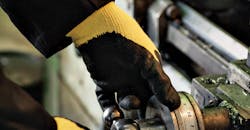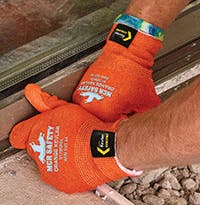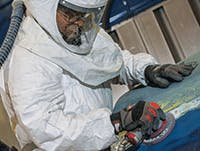With as many as 1 million hand injuries occurring in U.S. workplaces each year, hand protection is an important topic. Manufacturers continuously strive to improve the technology found in hand protection products, materials and construction, while staying on top of trends in the market.
We recently polled representatives from companies involved in the hand protection market to find the answers to these three questions:
• What trends are you seeing in hand protection for 2017-2018?
• What types/styles of hand protection are popular with your customers?
• Have you seen an increase in orders for hand protection? If so, do you think this signifies an increase in employment or production in manufacturing or construction?
Here are their answers…
Larry Garner, chief marketing officer, MCR Safety
Have you seen an increase in orders for hand protection? If so, do you think this signifies an increase in employment or production in manufacturing or construction? While the manufacturing industry has experienced job reduction since the 1960’s, safety awareness has grown significantly. Today’s employers must provide safe environments and distinguish themselves with low injury rates. Glove technology is making it possible to contribute to employee productivity as well as their safety.
Toby Cummings, sales representative, TurtleSkin Safety Products
What trends are you seeing in hand protection for 2017-2018? Since we specialize in both cut and puncture protection, we always are getting inquiries about hypodermic needle protection. This year, we’ve gotten a lot of interest from city and town municipalities looking to outfit their staff with our gloves to protect against discarded needles. We have many local government branches contacting us about selecting needle-resistant gloves. We’ve discussed glove solutions with local DOTs, local park cleanup crews and supervisors/workers with their local recycling centers.
Have you seen an increase in orders for hand protection? If so, do you think this signifies an increase in employment or production in manufacturing or construction? We have seen large increases in orders over the past year, specifically in the law enforcement and correctional markets.
Matt Burtney, content marketer, Superior Glove
Have you seen an increase in orders for hand protection? If so, do you think this signifies an increase in employment or production in manufacturing or construction? Requests for our gloves have steadily increased year-over-year. I think that this signifies an increase in awareness. Hand injuries are the second-most common workplace injury after back pai; so there’s a financial incentive to make sure employees are wearing their gloves.
Nico Janssen, regional business manager, High Protective Textiles, DSM Dyneema
What trends are you seeing in hand protection for 2017-2018? We continue to see interest in hand protection that offers optimal combination of cut resistance and comfort. [Using] innovative materials like Diamond Technology. Our partners are making ultra-thin, cut-resistant gloves that offer comfort and dexterity. This is enabling companies to provide workers who before wore no hand protection, or gloves that offered no cut protection, protective equipment that offers good cut protection. This is simply described as going from “no cut to some cut” by many in the PPE industry.
A second trend is a move toward greater cut protection, at least as defined by the new ANSI and EN388 cut resistance standards. Advanced materials enable greater cut protection in gloves the same thickness and weight as those made with previous generation materials
What types/styles of hand protection are popular with your customers? Ultra-thin gloves, in 18-gauge construction, remain very popular. Industries such as those requiring small metal parts handling, and applications such as packaging and shipping, have embraced these very thin, lightweight, comfortable and cut-resistant gloves. We also have seen an increase in interest in glove styles that offer launderability, products that can be washed multiple times and thus offer greater cost efficiency over time.
Have you seen an increase in orders for hand protection? If so, do you think this signifies an increase in employment or production in manufacturing or construction? In 2017, we have seen increased orders from our customers, who are some of the leading global PPE manufacturers. Many of these companies project further business increases in the second half of 2017 leading into 2018. We believe these are signs of improving manufacturing economies in key markets, including the United States. We expect hand protection – and cut-resistant hand protection in particular – to continue to grow faster than most other forms of PPE.
Steve Genzer, president and general manager, Ansell Industrial Solutions Global Business Unit
What types/styles of hand protection are popular with your customers? Gloves designed with ergonomics in mind continue to be popular. That’s no surprise from a safety manager or worker standpoint – muscle injuries caused by repetitive hand motions are a leading cause of workplace injury, which isn’t good for either party. Ergonomically enhanced gloves provide a higher level of comfort to support workers throughout the day.
Have you seen an increase in orders for hand protection? If so, do you think this signifies an increase in employment or production in manufacturing or construction? We’re seeing increased attention across all industries on worker safety and specifically hand protection. That’s manifesting itself in many ways – most importantly in improved employer awareness of and dedication to providing appropriate gloves for their workers.
Workplaces inevitably change, be it the number of employees, facility machinery or production output. With any change, reevaluation of safety products and protocol is imperative to ensure continued employee safety and success.
Andy Olson, product director, Ergodyne
What types/styles of hand protection are popular with your customers? The evolution of high-tech materials continues to fuel higher expectations from workers. More protection. More dexterity. More utility. Gloves that play nicely with today’s technology so wearers can keep them on while operating phones or tablets is almost a must at this point. EHSFor example, an “impact glove” is a common style featuring a palm padded in key vulnerable areas. In addition to protecting workers’ hands from the impact of a blow to the palm, their padded palms also provide protection from nuisance vibration. Typically, a half-finger design, impact gloves allow for excellent finger dexterity to perform common tasks.
About the Author

Sandy Smith
Sandy Smith is the former content director of EHS Today, and is currently the EHSQ content & community lead at Intelex Technologies Inc. She has written about occupational safety and health and environmental issues since 1990.







